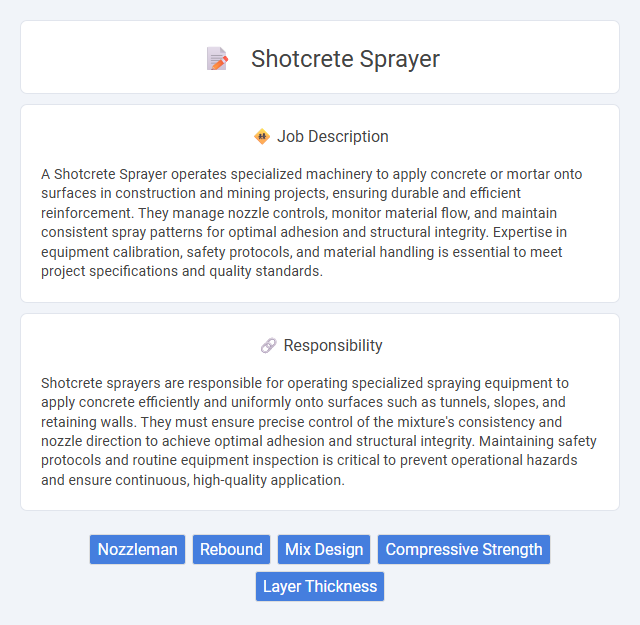
A Shotcrete Sprayer operates specialized machinery to apply concrete or mortar onto surfaces in construction and mining projects, ensuring durable and efficient reinforcement. They manage nozzle controls, monitor material flow, and maintain consistent spray patterns for optimal adhesion and structural integrity. Expertise in equipment calibration, safety protocols, and material handling is essential to meet project specifications and quality standards.
People with good physical stamina and strength are more likely to be suitable for a shotcrete sprayer job due to the demands of handling heavy equipment and working in various environmental conditions. Those comfortable with working at heights, in confined spaces, or on uneven surfaces might find this role fitting for their capabilities. Individuals who struggle with manual labor or have respiratory sensitivities may encounter challenges, reducing their suitability for this position.
Qualification
A Shotcrete Sprayer must possess extensive experience in operating shotcrete equipment, including dry-mix and wet-mix spraying systems, ensuring precise material application on surfaces. Proficiency in interpreting blueprints and construction plans is essential to meet structural specifications and safety standards. Certification in concrete spraying technology and knowledge of OSHA regulations further enhance job qualifications and workplace compliance.
Responsibility
Shotcrete sprayers are responsible for operating specialized spraying equipment to apply concrete efficiently and uniformly onto surfaces such as tunnels, slopes, and retaining walls. They must ensure precise control of the mixture's consistency and nozzle direction to achieve optimal adhesion and structural integrity. Maintaining safety protocols and routine equipment inspection is critical to prevent operational hazards and ensure continuous, high-quality application.
Benefit
Shotcrete sprayers likely enhance construction efficiency by enabling rapid and uniform application of concrete, reducing labor costs and project timelines. Their skillful operation probably improves surface adhesion and structural integrity, minimizing material waste and repair needs. Employing a shotcrete sprayer may increase safety by limiting manual handling of heavy materials, contributing to a safer work environment on-site.
Challenge
Facing the challenges of operating a shotcrete sprayer likely involves managing high-pressure equipment with precision to ensure consistent material application and structural integrity. There is a probability of encountering difficulties related to nozzle blockages, uneven spraying, and working in hazardous or confined environments requiring strict safety protocols. Mastery of the equipment and adaptability to varying project conditions could significantly impact project success and worker safety.
Career Advancement
A Shotcrete Sprayer career offers significant advancement opportunities through skill specialization in concrete spraying techniques and mastery of modern equipment like robotic sprayers. Professionals can progress to supervisory roles, project management, or technical training positions by gaining certifications such as Occupational Safety and Health Administration (OSHA) compliance and advanced shotcrete application methods. Continuous on-the-job experience and proficiency in safety protocols drive higher wages and leadership roles in construction and tunnel lining industries.
Key Terms
Nozzleman
A Shotcrete Sprayer Nozzleman specializes in operating the nozzle to accurately apply concrete mixtures onto surfaces for construction and repair projects. Precision in controlling the spray pattern and mixture flow is critical to ensure even application, strong adhesion, and surface durability. Expertise in equipment maintenance and safety protocols reduces material waste and enhances project efficiency in tunneling, mining, and structural reinforcement applications.
Rebound
Shotcrete sprayers specialize in applying concrete mixtures through pneumatic spraying, requiring precise control to minimize rebound--the concrete that bounces off the surface during application. Rebound typically accounts for 10-20% material loss, impacting project efficiency and cost, so skilled operators adjust nozzle angle, pressure, and distance to reduce waste. Effective management of rebound improves surface adhesion and ensures structural integrity in shotcrete applications for tunnels, mines, and retaining walls.
Mix Design
Shotcrete sprayers specialize in applying concrete using high-velocity spraying techniques, requiring an in-depth understanding of precise mix design formulations. Optimal mix designs for shotcrete balance cement, aggregates, water, and admixtures to achieve ideal workability, adhesion, and durability on various surfaces. Adjusting water-cement ratios and incorporating accelerators or fibers enhances setting time and structural integrity, ensuring efficient application and long-lasting results.
Compressive Strength
Shotcrete sprayers specialize in applying concrete mixtures using high-pressure spraying techniques, crucial for projects demanding rapid setting and durable surfaces. The compressive strength of shotcrete typically ranges from 20 to 40 MPa (megapascals), depending on the mix design and curing conditions, ensuring robust structural support. Optimizing parameters such as rebound rate, moisture content, and nozzle velocity maximizes the compressive strength, enhancing the longevity and stability of tunnels, retaining walls, and repair works.
Layer Thickness
Shotcrete sprayers apply concrete mixtures using high-pressure hoses to create durable layers in construction projects. Controlling layer thickness is critical, typically ranging from 2 to 4 inches per pass to ensure structural integrity and prevent material sagging or excessive rebound. Precision in maintaining consistent thickness enhances bonding strength and reduces the need for rework in tunnel linings, retaining walls, and slope stabilization.
 kuljobs.com
kuljobs.com